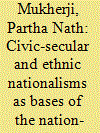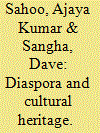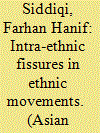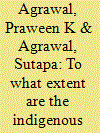|
|
|
Sort Order |
|
|
|
Items / Page
|
|
|
|
|
|
|
| Srl | Item |
| 1 |
ID:
095455


|
|
|
|
|
| Publication |
2010.
|
| Summary/Abstract |
The dominant Eurocentric paradigm of the nation and the nation-state was premised on western historical experience that was indigenous to the west but claimed universality for the rest. Many post-colonial countries, particularly those that went through national liberation struggles, like India and China, with multi-ethnic mobilisations, established sovereign states. The nationalist leaders claimed the unity of nationhood for their culturally diverse countries (states), with their millennia-deep civilisational identity, compelling a new discourse on the untenability of the classic Eurocentric paradigm. The second development witnessed the inevitable cultural heterogenisation of the western countries premised on the expansion of the (immigrant) labour market through an ever-enveloping regime of economic liberalisation and world trade. The catharsis of the invasion of cheaper labour from culturally diverse countries, often native-displacing, resulted in western countries attempting to accommodate the emerging changing reality in the context of mono-cultural nations through the concept and policy of multiculturalism. In spite of this, western countries have been witness to intercultural violence, racial discrimination and threats of home grown terrorism. The paper seeks to distinguish between 'pluralism' and 'multiculturalism' and argues for a reformulation of the concept of the nation-state that will have greater applicability across states.
|
|
|
|
|
|
|
|
|
|
|
|
|
|
|
|
| 2 |
ID:
095458


|
|
|
|
|
| Publication |
2010.
|
| Summary/Abstract |
This article investigates the practice and social meanings of cross-border journeys of Dai minority monks, in Xishuangbanna, Southwest China. These journeys play a vital part in Theravada revivalism in this border region. In the early 1990s, the Dai monks left Xishuangbanna to pursue their Buddhist studies in Thailand, thereby experiencing Thai culture and society. I will show not only that transnational networks among the Tai peoples in the upper Mekong region have played a crucial role in this religious movement, but also that the transnational Theravada networks enable and are partly constituted by the cross-border journeys of Dai exiles and minority monks, which strengthen and enhance the Dai ability to persist, revive, and maintain their locality and cultural identity. It is these cultural practices which contribute to and formulate the making of Dai places within the power contexts of state displacement, regional trade and development in Southwest China.
|
|
|
|
|
|
|
|
|
|
|
|
|
|
|
|
| 3 |
ID:
095460


|
|
|
|
|
| Publication |
2010.
|
| Summary/Abstract |
The present paper examines the historical and contemporary context of Indian communities in Canada from a cultural heritage perspective and analyses the processes of migration, settlement and cultural identity. It also examines the challenges of developing museum exhibits which depict the Indian diaspora in Canada. Despite its colourful history and its growing size and prominence in Canadian society, the Indian diaspora has not been the subject of much interest by Canadian museums. While recognising the necessity of working with local communities and thereby reflecting local concerns, it is submitted that any museum exhibit attempting to portray the complex set of experiences of the Indian diaspora in Canada should include some portrayal of the highly marginalised position which the Indian community faced when it first established themselves in the early 1900s. In addition to this historical focus, any attempt to portray the contemporary Indian diaspora needs to portray its growing diversity and its efforts to maintain, and in many cases modify and 'hybridise', cultural practices. Such a display would also have to reflect the influence of transnational forces on the contemporary Indian diaspora. Ultimately, efforts by museums to develop exhibits reflecting the Indian presence in Canada will only further the aims of its widely praised state policy of multiculturalism.
|
|
|
|
|
|
|
|
|
|
|
|
|
|
|
|
| 4 |
ID:
095457


|
|
|
|
|
| Publication |
2010.
|
| Summary/Abstract |
The article charts the rise of Mohajir identity politics in Pakistan since 1971. Most accounts of Mohajir identity politics have focused mainly on one actor, that is, the Mohajir (now Muttahida) Qaumi Movement and their politics and secondly, have remained silent on intra-ethnic fissures within the Mohajir community. The present article builds on and criticises such accounts for their partiality and presents a more nuanced understanding of politics within the Mohajir community. On the theoretical plane, it criticises modernist and primordialist accounts of ethnicity and nationalism, both of which portray a homogenous picture of ethnic groups as based on unity and shared aims. It is shown that unity and shared aims are at best, a chimera, and that intra-ethnic fissure is as important to understand as is inter-ethnic conflict when it comes to analysing ethnic movements.
|
|
|
|
|
|
|
|
|
|
|
|
|
|
|
|
| 5 |
ID:
095459


|
|
|
|
|
| Publication |
2010.
|
| Summary/Abstract |
Indigenous populations are the most marginalized and vulnerable communities in India, constituting 8.2% of India's total population, four times larger than the total population of Australia. The state of Jharkhand accounts for 27.7% of the total indigenous population of India. This paper compares the health and socio-economic and demographic indicators among indigenous and non-indigenous women in Jharkhand in terms of 'disadvantage ratio', by exploring the data of 1614 ever-married women (women who are currently married or who have been married at some point in their lives) from India's second National Family Health Survey (NFHS-2), conducted during 1998-99. The study revealed that the indigenous women of Jharkhand were highly disadvantaged in terms of socio-demographic, family planning, and important aspects of maternal health and nutrition compared to non-indigenous women. They were not only disadvantaged within the state in different parameters, but also across the indigenous female population of India as a whole. The findings call for urgent implementation of special health care strategies for reducing health and socio-economic/demographic disparities among the indigenous population of Jharkhand.
|
|
|
|
|
|
|
|
|
|
|
|
|
|
|
|
|
|
|
|
|